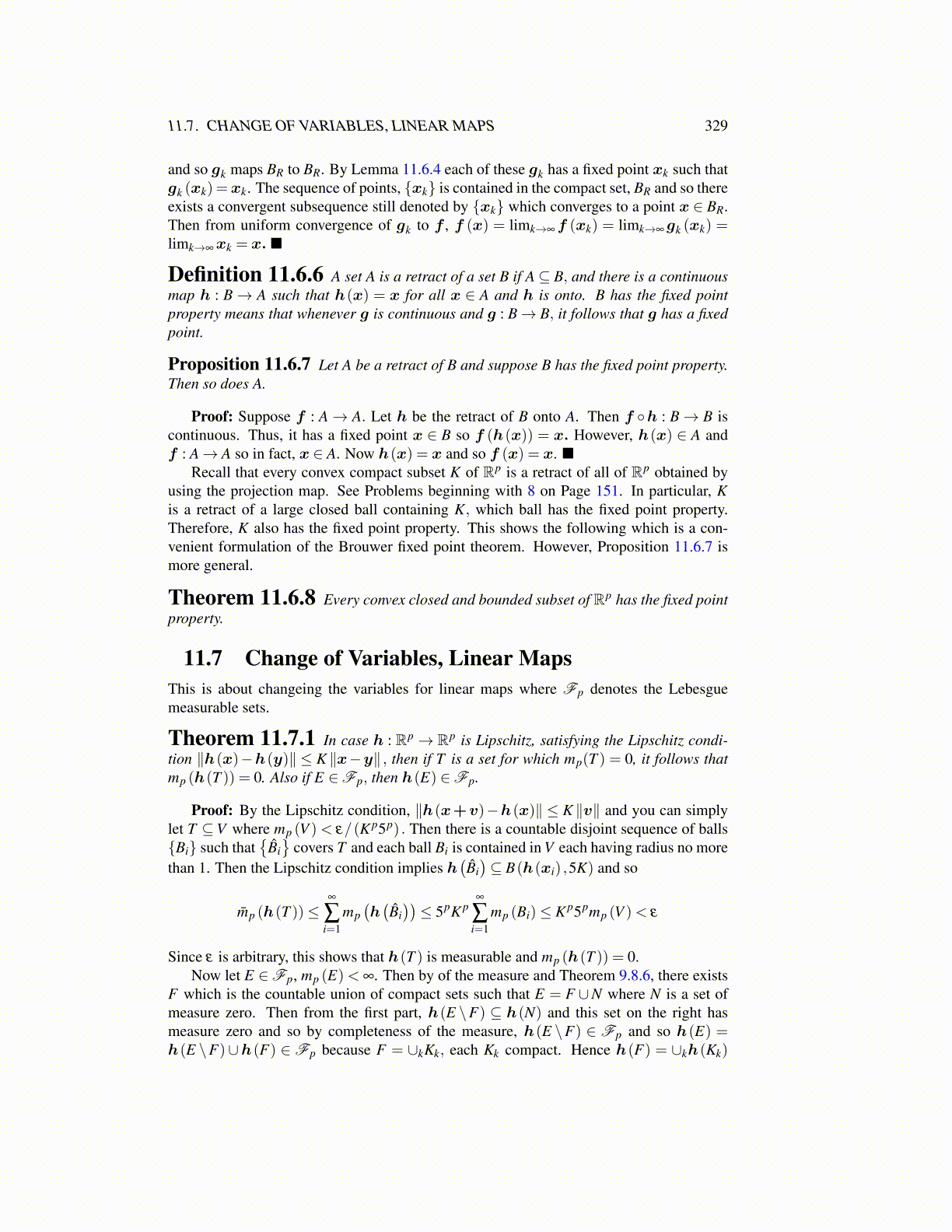
11.7. CHANGE OF VARIABLES, LINEAR MAPS 329
and so gk maps BR to BR. By Lemma 11.6.4 each of these gk has a fixed point xk such thatgk (xk) =xk. The sequence of points, {xk} is contained in the compact set, BR and so thereexists a convergent subsequence still denoted by {xk} which converges to a point x ∈ BR.Then from uniform convergence of gk to f , f (x) = limk→∞f (xk) = limk→∞gk (xk) =limk→∞xk = x. ■
Definition 11.6.6 A set A is a retract of a set B if A⊆ B, and there is a continuousmap h : B→ A such that h(x) = x for all x ∈ A and h is onto. B has the fixed pointproperty means that whenever g is continuous and g : B→ B, it follows that g has a fixedpoint.
Proposition 11.6.7 Let A be a retract of B and suppose B has the fixed point property.Then so does A.
Proof: Suppose f : A→ A. Let h be the retract of B onto A. Then f ◦h : B→ B iscontinuous. Thus, it has a fixed point x ∈ B so f (h(x)) = x. However, h(x) ∈ A andf : A→ A so in fact, x ∈ A. Now h(x) = x and so f (x) = x. ■
Recall that every convex compact subset K of Rp is a retract of all of Rp obtained byusing the projection map. See Problems beginning with 8 on Page 151. In particular, Kis a retract of a large closed ball containing K, which ball has the fixed point property.Therefore, K also has the fixed point property. This shows the following which is a con-venient formulation of the Brouwer fixed point theorem. However, Proposition 11.6.7 ismore general.
Theorem 11.6.8 Every convex closed and bounded subset of Rp has the fixed pointproperty.
11.7 Change of Variables, Linear MapsThis is about changeing the variables for linear maps where Fp denotes the Lebesguemeasurable sets.
Theorem 11.7.1 In case h : Rp → Rp is Lipschitz, satisfying the Lipschitz condi-tion ∥h(x)−h(y)∥ ≤ K ∥x−y∥ , then if T is a set for which mp(T ) = 0, it follows thatmp (h(T )) = 0. Also if E ∈Fp, then h(E) ∈Fp.
Proof: By the Lipschitz condition, ∥h(x+v)−h(x)∥ ≤ K ∥v∥ and you can simplylet T ⊆V where mp (V )< ε/(K p5p) . Then there is a countable disjoint sequence of balls{Bi} such that
{B̂i}
covers T and each ball Bi is contained in V each having radius no morethan 1. Then the Lipschitz condition implies h
(B̂i)⊆ B(h(xi) ,5K) and so
m̄p (h(T ))≤∞
∑i=1
mp(h(B̂i))≤ 5pK p
∞
∑i=1
mp (Bi)≤ K p5pmp (V )< ε
Since ε is arbitrary, this shows that h(T ) is measurable and mp (h(T )) = 0.Now let E ∈Fp, mp (E)< ∞. Then by of the measure and Theorem 9.8.6, there exists
F which is the countable union of compact sets such that E = F ∪N where N is a set ofmeasure zero. Then from the first part, h(E \F) ⊆ h(N) and this set on the right hasmeasure zero and so by completeness of the measure, h(E \F) ∈ Fp and so h(E) =h(E \F)∪h(F) ∈ Fp because F = ∪kKk, each Kk compact. Hence h(F) = ∪kh(Kk)